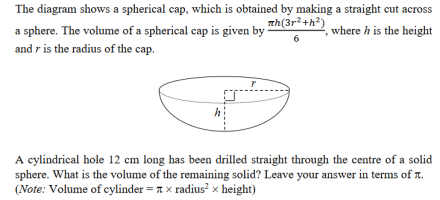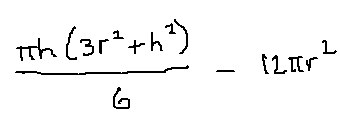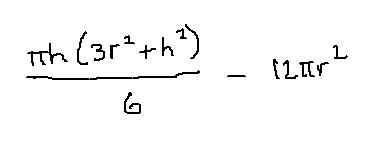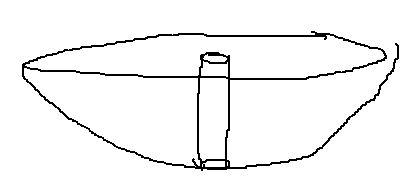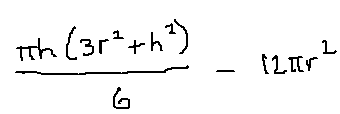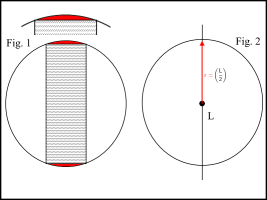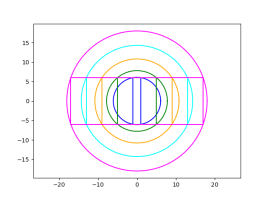spherical cap problem: volume is given by (pi * h(3r^2 + h^2))/6
- Thread starter nanase
- Start date
lev888
Elite Member
- Joined
- Jan 16, 2018
- Messages
- 2,995
Why? Note, that the hole is drilled through a sphere. I think you should start with a diagram.
lev888
Elite Member
- Joined
- Jan 16, 2018
- Messages
- 2,995
The hole is drilled through a sphere, not a spherical cap. Please read the problem statement carefully.to find the remaining volume = spherical cap - cylinder volume
I realized the cylinder radius is unknown, how do I proceed?
View attachment 37941
lev888
Elite Member
- Joined
- Jan 16, 2018
- Messages
- 2,995
Why spherical cap is important becomes clear when you draw a diagram, as I suggested.Okay I'll try again, so it shows spherical cap but has nothing to do with it?
volume of a sphere - volume of the cylinder will give the answer?
View attachment 37946
The Highlander
Senior Member
- Joined
- Feb 18, 2022
- Messages
- 1,169
Hi @nanaseView attachment 37937
I couldn't get the answer equal to 288π
I tried subtracting and did the following algebra :
I do realize the bottom of the sphere is not flat for this cylindrical reduction to work, what should I do?
No one should get 228π as the answer because that is not the correct answer!
(The correct answer is 288π cm3!
Clearly you were given an answer but was it given as "228π" or "228π cm3"? I ask because, if it was given as the latter but you have not included it properly, then it makes me wonder about the (apparent) question you have posted and whether it too is an accurate reproduction of what you were given.
I say that because the way it is laid out, it looks like you are expected to take into account the fact that when a cylindrical hole is drilled through the centre of a perfect sphere, then not only the volume of the cylinder (conveniently provided as: "π × radius2 × height") is removed but also a "spherical cap" is removed both at the top and the bottom of the cylinder! (See Fig. 1, below.)
This means that the volume of remaining solid (after the cylinder has been drilled out) would be the volume of the sphere less the volume of the cylinder and the volume of both of the spherical caps that are removed when the cylinder is drilled out.
The implication, therefore, given all the formulae that have been supplied in the picture you posted, is that you are expected to use the formulae for the volume of a spherical cap and the volume of a cylinder in conjunction with that for the volume of a sphere.
That might be possible using Integral Calculus (I haven't tried it) but I suspect that, given your very simplistic attempt at arriving at the final answer, doing so might well be beyond your capabilities.
However, it is not necessary to do any of that. Answering the second part of the problem (as you have posted it) does not rely on the first part in any way!
Calculating the volume of the remaining solid after a cylinder has been drilled through the centre of a perfect sphere is a 'classic' problem that involves a very simple formula!
The answer is completely independent of the radius of the sphere and the radius of the cylinder itself (which is, no doubt, why neither is supplied in the question).
The problem is (commonly) known as "the napkin ring problem" and the simplest way I can explain it is by reference to Fig. 2, above. If you allow the radius of the cylinder to shrink to zero (this can only be 'imagined', of course, but it would be possible for the radius to become so exceedingly small that it was "as good as" zero and the Maths holds if we just take its radius as zero) then the cylinder just becomes a line through the centre of length, L, and is also a diameter of the sphere.
The radius of the sphere, r, is, therefore, (2L) (See Fig. 2 again.)
But the volume of a sphere is 34πr3 so the simple formula for the volume of the remaining solid is just:-
34π(2L)3 cm3, where L is the length of the cylinder in cm.
Have you not been given that formula in your course?
Please now try using it and come back and show us what answer you get.
Maybe also post a bigger picture of the page you got the problem from too? (So we can see the whole context this was presented in.)
Hope that helps.
The highlander, thank you so much for your reply, I will try to look at your suggestion and post my workings as soon as possible. Your diagram (the red shaded part) made me realize how to use the formula given in this context.Hi @nanase
No one should get 228π as the answer because that is not the correct answer!
(The correct answer is 288π cm3!)
Clearly you were given an answer but was it given as "228π" or "228π cm3"? I ask because, if it was given as the latter but you have not included it properly, then it makes me wonder about the (apparent) question you have posted and whether it too is an accurate reproduction of what you were given.
I say that because the way it is laid out, it looks like you are expected to take into account the fact that when a cylindrical hole is drilled through the centre of a perfect sphere, then not only the volume of the cylinder (conveniently provided as: "π × radius2 × height") is removed but also a "spherical cap" is removed both at the top and the bottom of the cylinder! (See Fig. 1, below.)
This means that the volume of remaining solid (after the cylinder has been drilled out) would be the volume of the sphere less the volume of the cylinder and the volume of both of the spherical caps that are removed when the cylinder is drilled out.
The implication, therefore, given all the formulae that have been supplied in the picture you posted, is that you are expected to use the formulae for the volume of a spherical cap and the volume of a cylinder in conjunction with that for the volume of a sphere.
That might be possible using Integral Calculus (I haven't tried it) but I suspect that, given your very simplistic attempt at arriving at the final answer, doing so might well be beyond your capabilities.
However, it is not necessary to do any of that. Answering the second part of the problem (as you have posted it) does not rely on the first part in any way!
Calculating the volume of the remaining solid after a cylinder has been drilled through the centre of a perfect sphere is a 'classic' problem that involves a very simple formula!
The answer is completely independent of the radius of the sphere and the radius of the cylinder itself (which is, no doubt, why neither is supplied in the question).
The problem is (commonly) known as "the napkin ring problem" and the simplest way I can explain it is by reference to Fig. 2, above. If you allow the radius of the cylinder to shrink to zero (this can only be 'imagined', of course, but it would be possible for the radius to become so exceedingly small that it was "as good as" zero and the Maths holds if we just take its radius as zero) then the cylinder just becomes a line through the centre of length, L, and is also a diameter of the sphere.
The radius of the sphere, r, is, therefore, (2L) (See Fig. 2 again.)
But the volume of a sphere is 34πr3 so the simple formula for the volume of the remaining solid is just:-
34π(2L)3 cm3, where L is the length of the cylinder in cm.
Have you not been given that formula in your course?
Please now try using it and come back and show us what answer you get.
Maybe also post a bigger picture of the page you got the problem from too? (So we can see the whole context this was presented in.)
Hope that helps.
Yes the answer is 288π [cm cube], I don't recall ever writing 228.
The problem I posted is the whole thing, there is no other text nor diagram that I missed.
Last edited:
The Highlander
Senior Member
- Joined
- Feb 18, 2022
- Messages
- 1,169
You're very welcome but I thought I had made it clear (I certainly tried to), that you don't need to use the formulae that have been given in the question!The highlander, thank you so much for your reply, I will try to look at your suggestion and post my workings as soon as possible. Your diagram (the red shaded part) made me realize how to use the formula given in this context.
All you need is the simple formula I provided: 34π(2L)3 cm3, where L is the length of the cylinder in cm.
What do you get when you evaluate: 34π63, where 6 is half the the length of the 12 cm cylinder?
In you Original Post you wrote: "I couldn't get the answer equal to 288𝜋";Yes the answer is 288π [cm cube], I don't recall ever writing 228.
I was just pointing out that it should be: 288π cm3.
Hmmm, that's odd. I wonder if they were just trying to confuse you (by giving you that formula for the spherical cap first). Have you not been taught at all about how to calculate the remaining volume if a cylinder is drilled through the centre of a perfect sphere?The problem I posted is the whole thing, there is no other text nor diagram that I missed.
I considered using the volume of a sphere formula (34πr3), which wasn't given in the question, along with the two formulae that were provided but without the radii of the sphere and cylinder, the algebra soon became very messy; you can equate the diameter of the sphere to (L + 2h), where h is the height of the spherical caps, but that didn't help much.
If you are going to try to use the formulae provided to reach an answer then I wish you the best of luck!
Maybe someone else in the forum can offer a full algebraic solution that just hasn't occurred to me (or is beyond my abilities?).
(Perhaps @Dr.Peterson might wish to make a contribution?
Last edited:
Dr.Peterson
Elite Member
- Joined
- Nov 12, 2017
- Messages
- 16,808
First, note what Wikipedia says:
That is, there is no reason to assume that the answer will be independent of radius, except for the fact that the problem didn't give a radius; if you obtain an answer by assuming that, then you can't be sure the question wasn't just wrong (or incomplete). So you really want to show that the answer is independent of the radius, and can be expressed in terms of the length of the hole, alone.
Wikipedia gives a nice calculus-based proof; but of course the answer can be obtained directly from the volumes of a sphere, cylinder, and cylindrical cap, which appears to be the intent of the problem.
The algebraic approach is used here:

To do it using the variables we have here, suppose that the radius of the sphere is R, and the length of the hole is L (12 cm in the problem).
Now express h, the height of the cap, and r, the radius of the cap, in terms of R and L, put these into the volume formulas, and so some algebra.
Your first attempt will probably be messy, but with some reworking you should be able to make it fairly neat. And the answer will be very simple.
In geometry, the napkin-ring problem involves finding the volume of a "band" of specified height around a sphere, i.e. the part that remains after a hole in the shape of a circular cylinder is drilled through the center of the sphere. It is a counterintuitive fact that this volume does not depend on the original sphere's radius but only on the resulting band's height.
That is, there is no reason to assume that the answer will be independent of radius, except for the fact that the problem didn't give a radius; if you obtain an answer by assuming that, then you can't be sure the question wasn't just wrong (or incomplete). So you really want to show that the answer is independent of the radius, and can be expressed in terms of the length of the hole, alone.
Wikipedia gives a nice calculus-based proof; but of course the answer can be obtained directly from the volumes of a sphere, cylinder, and cylindrical cap, which appears to be the intent of the problem.
The algebraic approach is used here:

Spherical Ring -- from Wolfram MathWorld
A spherical ring is a sphere with a cylindrical hole cut so that the centers of the cylinder and sphere coincide, also called a napkin ring. Let the sphere have radius R and the cylinder radius r. From the right diagram, the surface area of the spherical ring is equal to twice that of a cylinder...
mathworld.wolfram.com
To do it using the variables we have here, suppose that the radius of the sphere is R, and the length of the hole is L (12 cm in the problem).
Now express h, the height of the cap, and r, the radius of the cap, in terms of R and L, put these into the volume formulas, and so some algebra.
Your first attempt will probably be messy, but with some reworking you should be able to make it fairly neat. And the answer will be very simple.
The Highlander
Senior Member
- Joined
- Feb 18, 2022
- Messages
- 1,169
That's where I gave up and just used the 34π(2L)3 formula but thank you for pointing out the best way to start (& further references) if one does want to arrive at the answer via the formulae provided (and some algebraic perseveranceYour first attempt will probably be messy, but with some reworking you should be able to make it fairly neat. And the answer will be very simple.
I'm sure the OP will now be in a better position to do what the question does appear to demand.
Perhaps s/he may come back and show us his/her efforts?
Thank you The Highlander,That's where I gave up and just used the 34π(2L)3 formula but thank you for pointing out the best way to start (& further references) if one does want to arrive at the answer via the formulae provided (and some algebraic perseverance).
I'm sure the OP will now be in a better position to do what the question does appear to demand.
Perhaps s/he may come back and show us his/her efforts?
I followed up on your superb hints :
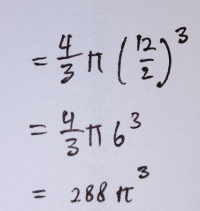
It got me thinking, why there is no radius in the answer (and why it's not given in the question itself). [which you have explained up there]
What effect does it have if the drill hole is big or small to the sphere?
From The Highlander and blamocur diagram I conclude they have cancelling out effect, which means if the radius of the hole is getting bigger, then the spherical cap on top and below will get bigger, but the spherical cap on the left and right become smaller? is my visualization correct?
From your illustration and explanation, it seems that when we calculate the remaining volume of a sphere when we drill through, the only key factor is the diameter of the sphere?
also I want to complain regarding the nature of the question itself, when they say hole of length 12cm, is it the distance of the top round arc to the bottom round arc, or from the top cylinder to the bottom cylinder? is it just me or the question is considered clear enough?
I think The Highlander approach is the best for this question as it is fast and less time spent to solve, I think this is a competition type question where I gotta be able to solve a question in less than 5 minutes.
Thank you so much The Highlander and others who helped me through this.
In the last line of your answer there is a stray "3" !Thank you The Highlander,
I followed up on your superb hints :
View attachment 37955
It got me thinking, why there is no radius in the answer (and why it's not given in the question itself). [which you have explained up there]
What effect does it have if the drill hole is big or small to the sphere?
From The Highlander and blamocur diagram I conclude they have cancelling out effect, which means if the radius of the hole is getting bigger, then the spherical cap on top and below will get bigger, but the spherical cap on the left and right become smaller? is my visualization correct?
From your illustration and explanation, it seems that when we calculate the remaining volume of a sphere when we drill through, the only key factor is the diameter of the sphere?
also I want to complain regarding the nature of the question itself, when they say hole of length 12cm, is it the distance of the top round arc to the bottom round arc, or from the top cylinder to the bottom cylinder? is it just me or the question is considered clear enough?
I think The Highlander approach is the best for this question as it is fast and less time spent to solve, I think this is a competition type question where I gotta be able to solve a question in less than 5 minutes.
Thank you so much The Highlander and others who helped me through this.
The answer should also include the unit of volume.
Dr.Peterson
Elite Member
- Joined
- Nov 12, 2017
- Messages
- 16,808
That depends on whether you already know the formula provided, which implies that you know that the answer is independent of radius. If you don't, then you have to either prove it, or trust that they only want an answer and allow it to be based on a guess.I think The Highlander approach is the best for this question as it is fast and less time spent to solve, I think this is a competition type question where I gotta be able to solve a question in less than 5 minutes.
I wouldn't consider this a contest problem, so much as a sort of trick problem. A problem that depends on having already seen the answer is not a contest problem; and I don't yet see a good way to do the algebra quickly.
Did you read my link?It got me thinking, why there is no radius in the answer (and why it's not given in the question itself). [which you have explained up there]
What effect does it have if the drill hole is big or small to the sphere?
As the radius R of the sphere shrinks, the diameter of the cylinder must also shrink in order that h can remain the same. The band gets thicker, and this would increase its volume. But it also gets shorter in circumference, and this would decrease its volume. The two effects exactly cancel each other out. In the extreme case of the smallest possible sphere, the cylinder vanishes (its radius becomes zero) and the height h equals the diameter of the sphere. In this case the volume of the band is the volume of the whole sphere, which matches the formula given above.
But that doesn't say it isn't surprising! (Counterintuitive, as they say earlier.)
lev888
Elite Member
- Joined
- Jan 16, 2018
- Messages
- 2,995
Draw a cylinder and a sphere around it.It got me thinking, why there is no radius in the answer (and why it's not given in the question itself). [which you have explained up there]
What effect does it have if the drill hole is big or small to the sphere?
Now draw a cylinder of the same height but with a radius 10 times the radius of the first cylinder. Draw a sphere around it. What do you notice about the 2 spheres?

